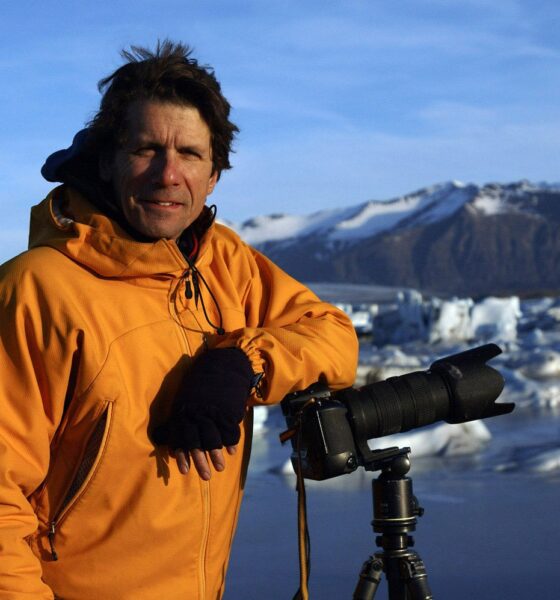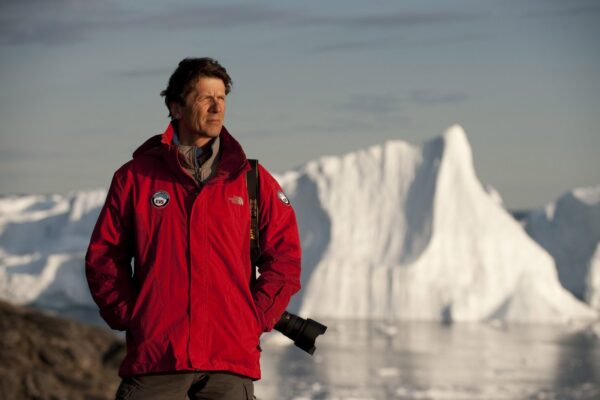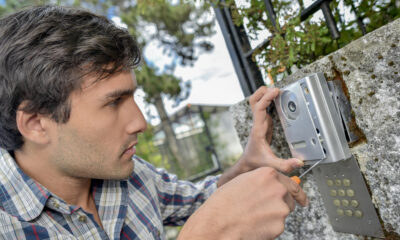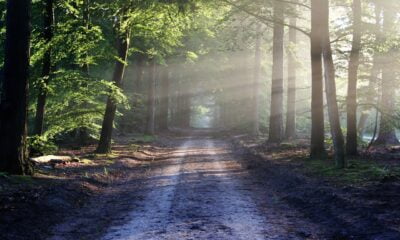

Features
Chasing Ice star James Balog on saving the planet: ‘I have to believe that there is still time’
Chasing Ice, a documentary film by Jeff Orlowski, is released in UK cinemas tomorrow (December 14). But beneath its beautifully-crafted images of some of the world’s biggest glaciers is one man’s pursuit to uncover irrefutable visual evidence of human-caused climate change.
James Balog, the American photographer whose Extreme Ice Survey project forms the basis of the film, battles through a number of personal obstacles to capture footage of ice in Greenland, Alaska and Iceland that will almost certainly never be seen again by the human eye.
I reviewed the film back in October – describing it as “one of the clearest and most devastatingly beautiful pieces of visual evidence for climate change you’ll see” – and yesterday, in a telephone interview from where he was staying in New York City, I spoke with Balog about his love for photography, pristine polar landscapes and gummy bears.
What first inspired you to look at the relationship between humans and nature?
That’s one of the best questions that I’ve ever had. Nobody asks me why I do that. And honestly, I’m not sure why. I was only in my 20s; I was a novice photographer just starting out. I had already been to graduate school and studied a lot of the science, and I was certainly inspired by the work of a photographer named Robert Adams, who lives not that far away from me. He’s not widely known in Europe or North America, except in the art museum circles, but Adams was thinking about some of the things that I eventually thought about. He was mostly looking at the urban and suburban edge of nature, and that was part of my thinking. Another part was the concerned photographer tradition of Eugene Smith and the Capa brothers, and thinking about conflict zones in essence.
And then finally, in spite of the fact that I was new to photography really, I was able to look at the traditional celebration of wilderness of images that were, and still are, so popular. Ansel Adams is still a very, very large figure and he just passed away when I started. But I was able to look at those pictures and say, “Gosh, there’s really nothing new that we can do with those kinds of celebratory pictures.” There were a lot of other things going on, but clearly talking about the glories of a waterfall or a granite cliff or a beautiful sunrise wasn’t enough; we’d already been there photographically. That reflex to look at it differently came to me from being a mountaineer, where we spend a lot of time thinking about new explorations. Where are the new places we can go? Part of that probably was programmed into how I was looking at photography.
In Chasing Ice, many of the images you’ve captured have never been seen by the human eye before – as you mention in the film. One of your most profound quotes, I think, is, “If I hadn’t seen it in the pictures, I wouldn’t have believed it at all”. Do you genuinely believe the film provides incontestable evidence of climate change?
Yeah, absolutely. I think it’s the strongest evidence that anybody’s put forth in a format that a layperson can understand. There has been lots and lots of incontestable evidence to come out of the science community in the form of graphs and numbers, and to the scientists, it’s already been incontestable for a really long time, but the public doesn’t have such an inherent understanding or appreciation of that science information. When it comes out in pictorial form, even more people can understand it than understood it before.
 There was a poll recently that placed both the US and UK quite low down in terms of the percentage of the public that actually accepts climate science. And we know as well that the well-funded climate change deniers sometimes seem to be in the ascendency. Why do you think it is that developed nations are rejecting the science?
There was a poll recently that placed both the US and UK quite low down in terms of the percentage of the public that actually accepts climate science. And we know as well that the well-funded climate change deniers sometimes seem to be in the ascendency. Why do you think it is that developed nations are rejecting the science?
I’m going to turn that around a little bit. I don’t know what the UK polls are showing, but the polls here in the US are showing that the acceptance of human-caused climate change is now in the upper 50%. And the acceptance of climate change as a concept is more than 70%. So it’s really come around after a lull there for a while, and I think there’s a strong majority that understands that climate change is real. People are understanding this based on the evidence of the senses and the human experience that’s going on in the world right now. It’s not obviously from our pictures; it’s from these extreme and violent weather events, all these odd things that keep happening and the understanding is finally getting out there that all of these things are connected to atmospheric instability – droughts, wildfires, floods, storms and the whole business.
I think Chasing Ice the strongest evidence [for climate change] that anybody’s put forth in a format that a layperson can understand
Sceptics, as you say, often don’t argue that climate change is actually happening; it’s the fact that it’s accelerated by human activity rather than just a natural occurrence. So based on what you’ve observed, what would you say to these people?
You have to dig a little bit deeper and you have to understand the scientific information a little bit more to understand that in fact, it is accelerated by human behaviours. The human connection is something that requires a willingness to observe and process the facts as they’ve been accumulated by thousands of very careful, very sceptical researchers from around the world. Merely the existence of a retreating glacier is not enough to say that this is a human acceleration of the problem; but when you take those pictures and combine them with scientific context, you’d have to be an ideologically-driven denier to ignore the fact that this is human caused.
Really, what the film does nicely is it combines the art and the science. It takes our visuals and puts it together with the scientific knowledge base and context so that by the end of it, you understand through the art and science, that this thing is real, happening and accelerated by humans.
How would you go about joining the dots in the heads of people watching this film in the cinema, between the things we do over here at home and the ice melting in the polar regions?
Really what you’re saying is, “We don’t have ice in our backyard in Manchester or London, so how does the story of this thing happening thousands of miles away belong to me?” Well, the climate change that is happening around your audience in the UK, which everybody talks about, is part of the series. You have to have an accumulation of measurements and life experiences to recognise how much it’s changing, and it’s hard to get that in your eyes. The eyes are the strongest sensing apparatus for humanity, and so if you can’t see atmospheric change because of the progression of events around you, it becomes challenging in places such as England where there are no glaciers to grasp it.
So what we’ve done is we’ve put climate change into a visual dimension for the first time. It’s really where you can see it, and the other part of this is that the idea of ice melting is something that anybody can grasp. A little baby understands it when Mummy puts an ice cube in the baby’s hand and the baby is sucking on the ice cube and watching it melt. You have a very animal sense of what that’s all about, and you have had that from the time when you were a year old. And so ice melting is something that people get in a way that they don’t get graphs and statistics.
Chasing Ice is coming out here in the UK tomorrow, but what were your objectives when you set out to make the film, and what impact do you hope it can have?
We actually did not intend to make the film. The film grew organically out of the Extreme Ice Survey (EIS). It was an afterthought. We had videographers out there from the beginning trying to record the field action, but whether or not a film would ever actually happen beyond something that was a traditional TV documentary was completely unknown. Jeff Orlowski, the director, and Paula DuPré Pesmen and Jerry Aronson, the producers – those guys came in several years into the EIS and started to talk about making a film out of this. I kind of washed by hands of it. I said, “I don’t want anything to do with it. It’s your deal; you go take care of it if you want to make this film.” So they did, and what you see there is the product of their efforts, not the product of me as the director of the EIS.
We’ve put climate change into a visual dimension for the first time
I think that the film brings the story home in a really compelling, emotional kind of way. There’s a lot of different angles to bring people in. It’s an adventure story, in these incredible wild landscapes that people don’t generally get to see; it’s an informational, scientific story; it’s a human interest story and I’ve just realised in the past few weeks that it’s a love story. It’s really an expression of a love story that our team has for these amazing landscapes. There are all these different levels that people can engage with it. A lot of the women engage with the trials and the tribulations of my wife and my kids, and the loss and the longing and the sadness of Daddy going away again.
Is humanity doing too little, too late, or do you remain optimistic about our planet’s future?
I’m worried that we might be doing too little, too late, but for the sake of my sanity, I can’t go there. I have to believe that there is still time. We are clearly in the middle of a crisis already. We are not looking at the crisis coming at us in the future; the crisis is upon us. One of the reasons I am optimistic is because I’m absolutely certain, based on all of the information I’ve been assimilating over the past six years, that we have the economic and technological solutions to this problem. We also have the policy solutions to this problem. What we’ve been lacking is political willpower which is a question of human perception. Human perception has been changing and now it’s incumbent on all of us to push hard on those political policymakers to get their act together and do what needs to be done.
This is a clear and present dangers; it’s right in front of us and we know that it has huge expenses attached to it. I’m in New York City as we speak, and New York City and New Jersey right across the river are about to spend $60 billion, more or less, to repair the damage from one storm. This is real, and people get hurt and have things happen when you don’t pay attention to the tangible evidence that’s right in front of you. That message is finally getting through.
Finally, I don’t know if you’re aware of a radio programme in the UK called Desert Island Discs. Basically, a celebrity would go on this programme and pick out various songs that they’d take with them to a desert island. They’d also be asked to pick one luxury item. So if you were stuck on a desert island, or to fit in with this conversation, an ice flow or iceberg, what one thing would you need with you and why?
There’s a gorgeous piece of music from Mendelssohn’s piano pieces, Songs Without Words. There’s actually about half a dozen of Mendelssohn’s songs that I would take as part of that. And then Chopin’s Nocturne.
I’m assuming you’d take your camera as well?
Yeah, but I don’t even consider that a luxury item; you have to take that. The luxury item would be little gummy bears. An endless supply. There’s nothing like getting in your sleeping bag after a long cold day out on the ice or in the wind and the rain, and then chomping down a few of those.
Chasing Ice is out in cinemas across the UK tomorrow (December 14).
Further reading:
Chasing Ice: climate change portrayed in devastatingly beautiful fashion

 There was a poll recently
There was a poll recently






























